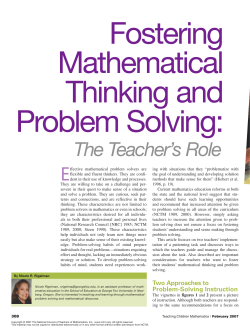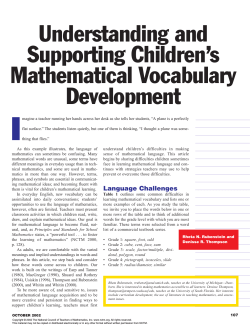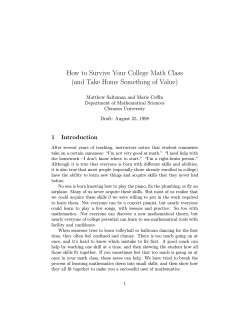
Course Proposal Form for Wright State Core
Course Proposal Form for Wright State Core (Form 1/11/10) Wright State Core courses provide students foundational skills, breadth of knowledge, and perspectives for integrating learning. Most Core courses will be part of Wright State’s Transfer Module and therefore should meet the requirements set by the Ohio Board of Regents. Narrowly focused technical or pre-technical courses and those primarily designed for skill development or as preparation for advanced study in a major are not typically approved by Ohio Transfer Module faculty review panels. With the exception of the second course in a Core sequence, Core courses should assume entry-level college proficiencies and, in general, not require additional prerequisites; therefore, courses proposed for the Core typically will be at the 1000 or 2000 level. Core courses should have a broad focus characteristic of general education and address one or more of the University Learning Objectives. Core courses should provide students experiences necessary to achieve all learning outcomes of the designated Element, including a basic understanding of the modes of inquiry common to the discipline(s) representative of the designated Element(s). A course that meets all learning outcomes of two Elements may be listed in both; credit for completing the course can be assigned to either Element (but not both). Colleges, departments, and pre-professional programs may require designated Core courses for their majors. Some Core courses, for example Honors Program Core Courses, may be open only to students who meet specific criteria. To propose a Core course please provide the following information. Department: Course Title: MTH Course Number ____2430 Mathematics Concepts for Teachers II Catalogue Course Description: Overview of mathematical topics from a perspective appropriate for early and middle childhood educators. Covers prime numbers and factorization, the operation of division on whole and rational numbers, ratio and proportion, probability, and data analysis. This course is being submitted for the following Element(s) of the Wright State Core (check as many as apply): _____ 1. Communication _____ 3. Global Traditions _____ 5. Social Science X 2. Mathematics _____ 4. Arts & Humanities _____ 6. Natural Science This course is also being submitted to satisfy the following requirement(s): Not applicable ___ Integrated Writing (IW) ___ Multicultural Competence ___ Honors ___ Service-Learning If one or more are checked please complete all relevant questions below. Course Proposal Form for Wright State Core, Page 2 Please attach a master syllabus following the template provided as part of this submission process and respond to the following items. See syllabus in Appendix. 1. Please describe how the course provides opportunities for students to meet the University Learning Objectives (as many as appropriate): a) communicate effectively b) demonstrate mathematical literacy c) evaluate arguments and evidence critically d) apply the methods of inquiry of the natural sciences, social sciences, or the arts and humanities e) demonstrate global and multicultural competence f) demonstrate understanding of contemporary social and ethical issues g) participate in democratic society as informed and civically engaged citizensMTH 2430 provides the following opportunities for students to demonstrate mathematical literacy. During Weeks 1 through 7 students explore fundamental ideas related to the operations of multiplication and division, ratio and proportion. Proportional reasoning forms the foundation for reasoning about probability. During Weeks 8 through 10 the focus is on probability. Probabilistic thinking is related to many models of scientific and social phenomena. During Weeks 11 through 14 the topic is data analysis, from the design of an investigation to the collection, analysis, and display of data and drawing valid conclusions from data. This portion of the course will develop statistical literacy so that participants can both critically evaluate statistical data and appreciate a statistical-based approach to decision-making. Concept and skill development will be accomplished through a variety of in-class problem solving experiences and homework assignments that include problem sets and essays. 2. How does the proposed course meet the learning outcomes for the Element(s) of the WS Core for which it is being submitted? Course meets Element 2 2. Mathematics The foundational skills required to use and interpret mathematics and statistics a. b. c. d. e. Identify the various elements of a mathematical or statistical model Determine the values of specific components of a mathematical/statistical model or relationships among various components Apply a mathematical/statistical model to a real-world problem Interpret and draw conclusions from graphical, tabular, and other numerical or statistical representations of data Summarize and justify analyses of mathematical/statistical models for problems, expressing solutions using an appropriate combination of words, symbols, tables or graphs Proposal for MTH 2430 to be in the WS Core, 5/6/11, AMF, mod 5/27/11 REM Course Proposal Form for Wright State Core, Page 3 How does the course meet all of the above learning outcomes for Element 2 of the WS Core? Items (a) through (e) in Element 2 of the WSU Core will be addressed in the following ways. Identify the various elements of a mathematical or statistical model. Syllabus Topics: Data Analysis, Designing Investigations Sample Homework or Exam Item: 100,000 randomly selected adults were asked whether they drink at least 48 oz of water each day and only 45% said yes. Identify the population, sample, variable and statistic. Is this sample representative? Explain. b. Determine the values of specific components of a mathematical/statistical model or relationships among various components. Syllabus Topics: Data Analysis and Statistical Reasoning, Displaying Data Sample Homework or Exam Item: Examine the data on Infant Mortality for the countries listed on the handout (from CIA World Factbook). Create a boxplot for the data. Write four statements to describe what you can learn about the data from this plot. c. Apply a mathematical/statistical model to a real-world problem. Syllabus Topics: Ratio and Proportion Sample Homework or Exam Item:A convenience store advertised two phone cards. Which card would you buy? Card 1: 3.9 cents per minute with a 37 cent connection charge for each call. Card 2: 7.9 cents per minute and no connection charge. Describe the assumptions you needed to make in order to solve the problem. Suppose the frequencies for the incidence of a disease and the accuracy of a diagnostic medical test, Test A, are given in the two-way table below: Have the Disease Do Not Have the Disease Totals Test A is Positive 35 65 100 Test A is Negative 5 895 900 40 960 1000 Totals 1. Determine the probability that a person has the disease. 2. Determine the probability that a person has the disease, assuming their test result is positive. If a person’s test result is negative, what is the probability that they have the disease? 3. Determine the probability that a person does not have the disease. 4. Determine the probability that a person does not have the disease, assuming their test result is positive. If a person’s test result is negative, what is the probability that they do not have the disease? Proposal for MTH 2430 to be in the WS Core, 5/6/11, AMF, mod 5/27/11 REM Course Proposal Form for Wright State Core, Page 4 d. Interpret and draw conclusions from graphical, tabular, and other numerical or statistical representations of data. Syllabus Topics: Ratio and Proportion, Data Analysis Sample Homework or Exam Item: The data below show the estimated number of AIDS cases in 2004 by ethnicity. For each group of people, determine the AIDS rate per 100,000 population. Describe how the rates give a different picture than the raw numbers alone. (FROM: Explorations by Bassarear) Ethnicity Estimated AIDS cases in 2004 Population (millions) White, not Hispanic 12,013 197.8 Black, not Hispanic 20,965 37.5 Hispanic 8,672 41.3 Asian 488 12.8 American Indian 193 2.8 e. Summarize and justify analyses of mathematical/statistical models for problems, expressing solutions using an appropriate combination of words, symbols, tables or graphs. Syllabus Topics: Data Analysis, Displaying Data, Distribution Sample Homework or Exam Item: Twenty four workers were surveyed about how long it takes them to travel to work each day. The data below are given in minutes. Construct a stem-and-leaf plot. What can you learn about their commutes from this graph? 20 23 58 35 24 30 42 22 32 52 20 48 65 41 37 20 25 47 60 28 24 49 27 50 3. Normally, courses in the Wright State Core, by their nature, have no prerequisites. If students must meet certain requirements to take the proposed course, please list them and explain (a) why completion of the high school college prep curriculum is not sufficient for this course, and (b) exactly how any special requirements will aid the successful completion of the course. MTH 2430 will be the second course in a three-course sequence required for all Early Childhood Education and Middle Childhood Education majors. MTH 2430 will serve two purposes for its audience. It will provide part of the mathematics foundation necessary for teaching Grade K-8 mathematics. We propose that it also satisfy the Mathematics requirement (Element 2) of the Wright Core. The prerequisite for MTH 2430 is MTH 2410. Topics in MTH 2410 include number systems and the operations of addition, subtraction and multiplication. Emphasis will be on concepts and making sense of properties and algorithms for operations with whole numbers, fractions, and rational numbers. More than half Proposal for MTH 2430 to be in the WS Core, 5/6/11, AMF, mod 5/27/11 REM Course Proposal Form for Wright State Core, Page 5 of the students who enroll in MTH 2410 need this review of number concepts and algorithms in order to successfully perform calculations. All of the students need MTH 2410 to prepare to teach these concepts and skills. To enroll in MTH 2430, students must pass MTH 2410 with a grade of C or above and meet minimum arithmetic skill requirements. These requirements are necessary to enable students to learn the mathematics in MTH 2430 with sufficient depth to prepare for a teaching career. 4. Describe how you will evaluate the effectiveness of this course in meeting the University Learning Objective(s) identified in question 1 and the learning outcomes of the Element(s) for which it is being proposed. Specifically address: a) Methods used to gather student perceptions of the course and how well it meets the stated learning outcomes (for example, a standard questionnaire about student perception is now distributed in GE classes; some adaptation of this questionnaire will be available; also indicate any other tools used) Students will be asked to complete the standard questionnaire about their perception of the course and how well the course meets the Wright State Core Element 2. Their responses will be collected (in each section of the course), and analyzed and summarized. An annual report will be produced by the Mathematics Education Advisory Committee in the Department of Mathematics and Statistics. b) Strategies for directly assessing student learning outcomes (examples could include exams, papers, portfolios, other assignments) Representative student responses to common items in the problem sets, essay assignments, midterms and final exams will be collected (in each section of the course), analyzed and summarized. An annual report will be produced by the Mathematics Education Advisory Committee in the Department of Mathematics and Statistics. c) Strategies for analyzing the results of the assessment and for communicating the findings to those responsible for course improvements and to the University General Education Committee (UGEC) An annual report will be produced by the Mathematics Education Advisory Committee in the Department of Mathematics and Statistics and made available to the course coordinators and to the UGEC. Proposal for MTH 2430 to be in the WS Core, 5/6/11, AMF, mod 5/27/11 REM Course Proposal Form for Wright State Core, Page 6 5. Who will teach this course? Please list the name, rank, and department affiliation of each individual likely to teach the course in the first two years of the Wright State Core. Aina Appova, PhD, Assistant Professor Departments of Mathematics and Statistics, Teacher Education Timothy Boester, PhD, Assistant Professor Departments of Mathematics and Statistics, Teacher Education Glenn Dahl, Lecturer Department of Mathematics and Statistics Ann Farrell, PhD, Professor Department of Mathematics and Statistics Paulette Zizzo, Lecturer Department of Mathematics and Statistics 6. Whom may UGEC contact with any questions about this particular course and its assessment (name, campus phone, email address)? Ann Farrell, Department of Mathematics and Statistics, 120 MM Bldg ann.farrell@wright.edu, 775.2193, 213 MM Bldg Paulette Zizzo, Department of Mathematics and Statistics, 120 MM Bldg paulette.zizzo@wright.edu, 775.4956, 115 MM Bldg (Note: Items 7-10 on Form 1-11-10 are not applicable.) Proposal for MTH 2430 to be in the WS Core, 5/6/11, AMF, mod 5/27/11 REM Course Proposal Form for Wright State Core, Page 7 APPENDIX Syllabus for MTH 2430 I. Course Information Course Title: Mathematics Concepts for Teachers II Course Abbreviation and Number: MTH 2430 Mathmtcl Concept Tchr II Course Credit Hours: 3 semester hours Course Meeting Times: Course will be offered both Fall and Spring semesters with at least one evening offering per year. Course will meet twice per week. Course will be offered during the daytime in the Summer if enrollment warrants. II. Course Materials Textbook (required): Beckmann, S. (2007). Mathematics for Elementary Teachers plus Activities Manual (2nd Edition). Addison Wesley Materials (recommended): 3 ring binder or pocket folder, calculator, ruler, colored pencils or markers III. Course Objectives This course can be used to satisfy Element 2 in the WSU Core, and is designed to meet the associated Learning Outcomes: a. Identify the various elements of a mathematical or statistical model b. Determine the values of specific components of a mathematical/statistical model or relationships among various components c. Apply a mathematical/statistical model to a real-world problem d. Interpret and draw conclusions from graphical, tabular, and other numerical or statistical representations of data e. Summarize and justify analyses of mathematical/statistical models for problems, expressing solutions using an appropriate combination of words, symbols, tables or graphs Course learning outcomes are targeted to deepen the existing knowledge of grades PreK-8 teacher candidates about number theory, rational numbers, probability, and data analysis. Content learning outcomes include: number theory (factors, greatest common factor, least common multiple, prime numbers), the operation of division (what division means, why the long division algorithm works, alternative division algorithms, dividing fractions and decimals), ratio and proportion (applications, problem solving in real-world contexts), probability (likelihood of outcomes, independent vs. dependent events, calculation), and data analysis (designing investigations, displaying data, measures of central tendency, distribution). Process learning outcomes include: inquiry-based learning, communicating mathematical ideas, exploring different representations, investigating tools appropriate for PreK-8 mathematics, developing and testing conjectures, and developing mathematical justifications. Proposal for MTH 2430 to be in the WS Core, 5/6/11, AMF, mod 5/27/11 REM Course Proposal Form for Wright State Core, Page 8 IV. Course Prerequisites Prerequisites: Minimum Grade of C in MTH 2410 Corequisites: none Restrictions: none Other: none V. Method of Instruction Lecture/Lab/Discussion combination VI. Evaluation and Policy Attendance (5%), Problem Sets (5%), Reviews of Teaching-Focused Journal Articles (5%), Essays that Explain Mathematical and Statistical Concepts (10%), Midterms (55%), and Final Exam (20%) VII. Grading Policy 90-100% A, 80-89% B, 70-79% C, 60-69% D, below 60% F VIII. Assignments and Course Outline Weeks 1 through 3: Number Theory (factorization, CGF, LCM, prime numbers) Weeks 4 through 5: Division (what division means, why the long division algorithm works, alternative division algorithms, dividing fractions and decimals) Weeks 6 through 7: Ratio and Proportion (applications, problem solving in real-world contexts) Weeks 8 through 10: Probability (likelihood of outcomes, independent vs. dependent events, calculation) Weeks 11 through 13: Data Analysis (designing investigations, displaying data, measures of central tendency, distribution) Week 14: Review IX. Other Information Students entering this course who believe they have a disability subject to the ADA, and/ or students who believe they may need accommodation, should contact the University's Office of Disability Services (ODS), E186 Student Union, (937) 775-5680; TTY: (937) 775-5844. The ODS will evaluate the student's needs and recommend reasonable accommodation to the instructor of this course. Proposal for MTH 2430 to be in the WS Core, 5/6/11, AMF, mod 5/27/11 REM
© Copyright 2025









![This article was downloaded by: [Simon Fraser University] Publisher: Routledge](http://cdn1.abcdocz.com/store/data/000214536_1-d186908b582356baad1e25048dce0c49-250x500.png)

